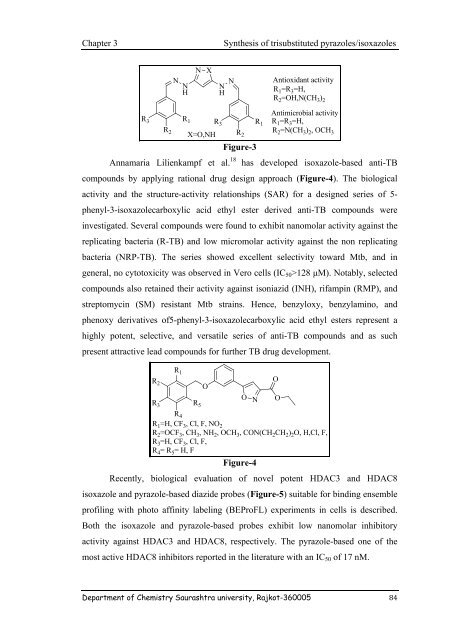Download (6Mb) - Etheses - Saurashtra University
Download (6Mb) - Etheses - Saurashtra University
Download (6Mb) - Etheses - Saurashtra University
You also want an ePaper? Increase the reach of your titles
YUMPU automatically turns print PDFs into web optimized ePapers that Google loves.
Chapter 3<br />
Synthesis of trisubstituted pyrazoles/isoxazoles<br />
N X<br />
N<br />
N<br />
Antioxidant activity<br />
N N<br />
H H<br />
R 1 =R 3 =H,<br />
R 2 =OH,N(CH 3 ) 2<br />
Antimicrobial activity<br />
R 3 R 1 R 3 R 1<br />
R 1 =R 3 =H,<br />
R 2 R R 2 2 =N(CH 3 ) 2 ,OCH<br />
X=O,NH<br />
3<br />
Figure-3<br />
Annamaria Lilienkampf et al. 18 has developed isoxazole-based anti-TB<br />
compounds by applying rational drug design approach (Figure-4). The biological<br />
activity and the structure-activity relationships (SAR) for a designed series of 5-<br />
phenyl-3-isoxazolecarboxylic acid ethyl ester derived anti-TB compounds were<br />
investigated. Several compounds were found to exhibit nanomolar activity against the<br />
replicating bacteria (R-TB) and low micromolar activity against the non replicating<br />
bacteria (NRP-TB). The series showed excellent selectivity toward Mtb, and in<br />
general, no cytotoxicity was observed in Vero cells (IC 50 >128 μM). Notably, selected<br />
compounds also retained their activity against isoniazid (INH), rifampin (RMP), and<br />
streptomycin (SM) resistant Mtb strains. Hence, benzyloxy, benzylamino, and<br />
phenoxy derivatives of5-phenyl-3-isoxazolecarboxylic acid ethyl esters represent a<br />
highly potent, selective, and versatile series of anti-TB compounds and as such<br />
present attractive lead compounds for further TB drug development.<br />
R 1<br />
R 5<br />
R 2<br />
R 3<br />
O<br />
O N<br />
O<br />
O<br />
R 4<br />
R 1 =H, CF 3 ,Cl,F,NO 2<br />
R 2 =OCF 3 ,CH 3 ,NH 2 ,OCH 3 , CON(CH 2 CH 2 ) 2 O, H,Cl, F,<br />
R 3 =H, CF 3 ,Cl,F,<br />
R 4 =R 5 =H,F<br />
Figure-4<br />
Recently, biological evaluation of novel potent HDAC3 and HDAC8<br />
isoxazole and pyrazole-based diazide probes (Figure-5) suitable for binding ensemble<br />
profiling with photo affinity labeling (BEProFL) experiments in cells is described.<br />
Both the isoxazole and pyrazole-based probes exhibit low nanomolar inhibitory<br />
activity against HDAC3 and HDAC8, respectively. The pyrazole-based one of the<br />
most active HDAC8 inhibitors reported in the literature with an IC 50 of 17 nM.<br />
Department of Chemistry <strong>Saurashtra</strong> university, Rajkot-360005 84

















